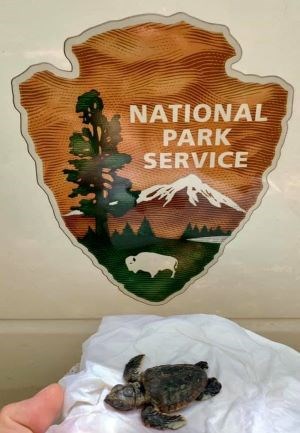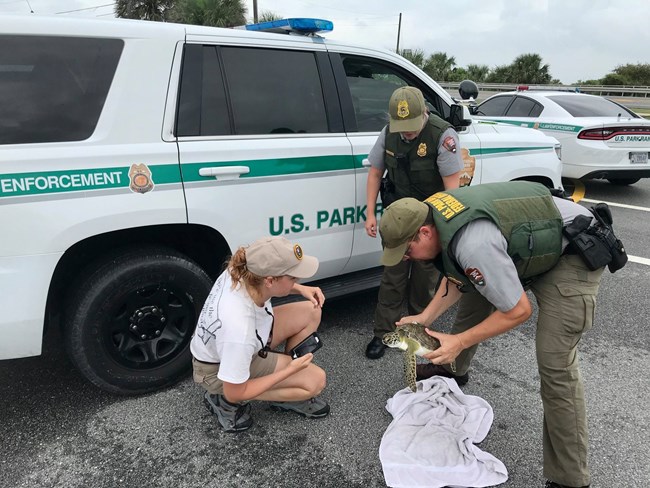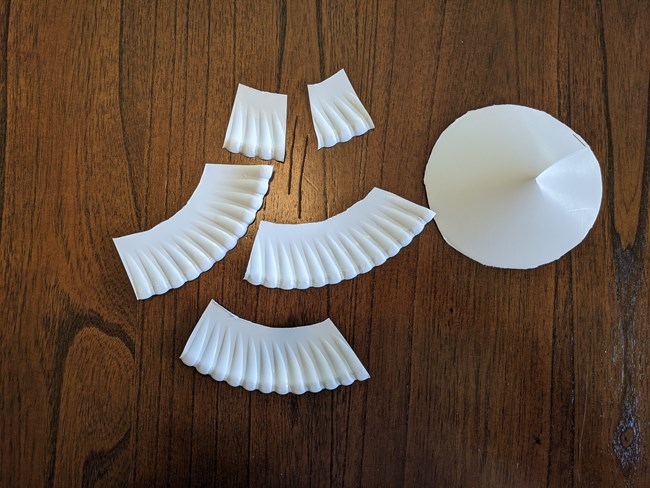Last updated: September 1, 2020
Article
Turtle Activity
Types of Sea Turtles

Left image
Question: What is it?
Right image
Answer: slide to reveal.

Left image
Question: What is it?
Right image
Answer: slide to reveal.
Left image
Question: What is it?
Right image
Answer: slide to reveal.

Left image
Question: What is it?
Right image
Answer: slide to reveal.
Credit: (Image credit: NOAA)

Left image
Question: What is it?
Right image
Answer: slide to reveal.
Nesting and Hatching
- Duration:
- 2 minutes, 46 seconds
A story about how a mother sea turtle creates the next generation of baby sea turtles. Visual description of video: A uniformed National Park Service Ranger kneels at the base of a sea turtle nest. The background contains the Fort Matanzas beach and dunes.

Turtle season in Florida is from March to October. This image was taken at Fort Matanzas (June 2020). The tracks indicate it was a loggerhead turtle. Park staff got right to work securing the nest and reporting the data. Loggerhead females crawl up the beach at night, meticulously select a spot, and use their flippers to dig a body pit and egg chamber. They then deposit their eggs in the chamber, cover them, and crawl back down the beach to the water. The process can take two hours or more.
- Duration:
- 2 minutes, 37 seconds
Learn how sea turtles hatch. Visual description of video: A uniformed National Park Service Ranger kneels at the base of a sea turtle nest. The background contains the Fort Matanzas beach and dunes.
Protecting Turtles

What Can You and Your Family Do to Protect Sea Turtles?
- Fill in holes and knock down sand castles before you leave the beach. They can become obstacles for nesting turtles or emerging hatchlings.
- Reduce marine debris that may entangle or be accidentally eaten by sea turtles.
- Participate in coastal clean-ups and reduce plastic use to keep our beaches and ocean clean. Trash in the ocean can harm sea turtles and other creatures that live there.
- Carry reusable water bottles and shopping bags. Refrain from releasing balloons, they'll likely end up in the ocean where sea turtles can mistake them for prey and consume them.
- Keep nesting beaches dark and safe for sea turtles. Turn off, shield, or redirect lights visible from the beach. Lights disorient hatchling sea turtles and discourage nesting females from coming onto the beach to lay their eggs.
- Do not disturb nesting turtles, nests, or hatchlings. Attend organized sea turtle watches that know how to safely observe nesting sea turtles.
- Remove beach equipment like chairs and umbrellas at night so sea turtles are not turned away.
- Remember, turtles have to come up to the surface for air, and they can be difficult to see. Boat strikes are a serious threat to sea turtles, so slow down and steer around them.
- If you see a sick or injured sea turtle, contact a ranger, deputy, or FWC's 24-hour Wildlife Alert at 1-888-404-FWCC (1-888-404-3922).

This little loggerhead hatchling washed up on the Fort Matanzas beach (August 2020). He was very lethargic from struggling in the strong surf. Luckily a concerned visitor flagged down one of our law enforcement rangers patrolling the beach for assistance. Rangers immediately transported him to The Sea Turtle Hospital at UF Whitney Lab at Marineland, FL for the best success at making a full recovery.

This is a deceased green sea turtle discovered on the beach at Fort Matanzas (June 2020), with a large crack in its carapace (dorsal shell). It was most likely made by a boat propeller or the hull of a jet ski when it hit the turtle at high speed. Green sea turtles often swim in the Matanzas River, feeding on the aquatic plants that grow in the shallows.

This juvenile green sea turtle swallowed a fisherman's hook which became lodged in her throat (June 2020). Fort Matanzas Rangers collected photos for Florida Fish and Wildlife and transported the turtle to The Sea Turtle Hospital at UF Whitney Lab where the hook was successfully removed. She was released back in the Atlantic Ocean.
- Duration:
- 2 minutes, 5 seconds
What the NPS is doing and what YOU can do to help sea turtles. Visual description of video: A uniformed National Park Service Ranger kneels at the base of a sea turtle nest. The background contains the Fort Matanzas beach and dunes.
Craft Activity
Make Your Own Turtle
This turtle is easy to make. Play with it, use it as a wall decoration, wear it as a hat (add some ties to the edge of the shell), or make several for a turtle mobile.
Materials: A white paper plate, scissors, pencil, stapler, short piece of string, black waterproof pen or black marker, ruler, and green and brown (or your favorite colors) paint.


Step 2: Make a cut from the edge to the center of the plate, and overlap and staple the two edges together to make the turtle’s shell.

Step 3: Cut three 3 inch long pieces, and two 1.5 inch pieces from the rim.

Step 4: Trim the pieces to make two front flippers and a head, and two back flippers.

Step 5: Staple the head and flippers to the edges of the shell as shown. Use a waterproof pen or black marker to draw small scales on them, and give the head some eyes and nostrils.

Step 6: Paint the shell a greenish-brown color and the flippers and head brown (or use your favorite colors and be creative!).
Make a knot in one end of a short piece of string. Thread it through the center of the shell from underneath and tie a small loop in the top end. Have fun playing with your turtle.
Share With Us
With your parents' permission, take a picture of your turtle and share it with us on social media (@fortmatanzasnps)!
